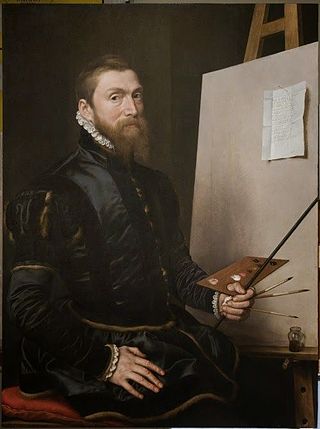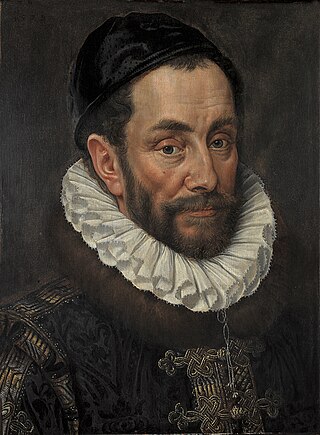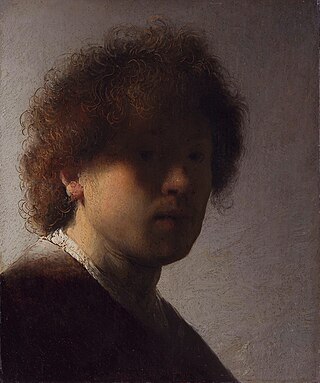
Jan Josephszoon van Goyen was a Dutch landscape painter. The scope of his landscape subjects was very broad as he painted forest landscapes, marine paintings, river landscapes, beach scenes, winter landscapes, cityscapes, architectural views and landscapes with peasants. The list of painters he influenced is much longer. He was an extremely prolific artist who left approximately twelve hundred paintings and more than one thousand drawings.

Sir Anthony van Dyck was a Flemish Baroque artist who became the leading court painter in England after success in the Spanish Netherlands and Italy.

Adriaen Isenbrandt or Adriaen Ysenbrandt was a painter in Bruges, in the final years of Early Netherlandish painting, and the first of the Dutch and Flemish Renaissance painting of the Northern Renaissance. Documentary evidence suggests he was a significant and successful artist of his period, even though no specific works by his hand are clearly documented. Art historians have conjectured that he operated a large workshop specializing in religious subjects and devotional paintings, which were executed in a conservative style in the tradition of the Early Netherlandish painting of the previous century. By his time, the new booming economy of Antwerp had made this the centre of painting in the Low Countries, but the previous centre of Bruges retained considerable prestige.

Anthonis Mor, also known as Anthonis Mor van Dashorst and Antonio Moro, was a Netherlandish portrait painter, much in demand by the courts of Europe. He has also been referred to as Antoon, Anthonius, Anthonis or Mor van Dashorst, and as Antonio Moro, António Mouro, Anthony More, etc., but signed most of his portraits as Anthonis Mor.

Nicolaes Maes was a Dutch painter known for his genre scenes, portraits, religious compositions and the occasional still life. A pupil of Rembrandt in Amsterdam, he returned to work in his native city of Dordrecht for 20 years. In the latter part of his career he returned to Amsterdam where he became the leading portrait painter of his time. Maes contributed to the development of genre painting in the Netherlands and was the most prominent portrait painter working in Amsterdam in the final three decades of the 17th century.

Cesar Pietersz, or Cesar Boetius van Everdingen, older brother of Allart van Everdingen and Jan van Everdingen, was a Dutch Golden Age portrait and history painter.

Jan Davidsz. de Heem or in-full Jan Davidszoon de Heem, also called Johannes de Heem or Johannes van Antwerpen or Jan Davidsz de Hem, was a still life painter who was active in Utrecht and Antwerp. He is a major representative of that genre in both Dutch and Flemish Baroque painting.

Petrus Christus was an Early Netherlandish painter active in Bruges from 1444, where, along with Hans Memling, he became the leading painter after the death of Jan van Eyck. He was influenced by van Eyck and Rogier van der Weyden and is noted for his innovations with linear perspective and a meticulous technique which seems derived from miniatures and manuscript illumination. Today, some 30 works are confidently attributed to him. The best known include the Portrait of a Carthusian (1446) and Portrait of a Young Girl ; both are highly innovative in the presentation of the figure against detailed, rather than flat, backgrounds.

Jan Lievens was a Dutch Golden Age painter who was associated with his close contemporary Rembrandt, a year older, in the early parts of their careers. They shared a birthplace in Leiden, training with Pieter Lastman in Amsterdam, where they shared a studio for about five years until 1631. Like Rembrandt he painted both portraits and history paintings, but unlike him Lievens' career took him away from Amsterdam to London, Antwerp, The Hague and Berlin.

Frans Pourbus the Elder was a Flemish Renaissance painter who is known primarily for his portraits and religious compositions, as well as a few genre scenes. He was the son of the prominent Bruges painter and cartographer Pieter Pourbus and the father of Frans Pourbus the Younger who became an international portraitist of the European ruling class.

Juan van der Hamen y (Gómez de) León was a Spanish painter, a master of still life paintings, also called bodegones. Prolific and versatile, he painted allegories, landscapes, and large-scale works for churches and convents. Today he is remembered mostly for his still lifes, a genre he popularized in 1620s Madrid.

Adriaen Hanneman was a Dutch Golden Age painter best known for his portraits of the exiled British royal court. His style was strongly influenced by his contemporary, Anthony van Dyck.

Jan Cossiers was a Flemish painter and draughtsman. Cossiers' earliest works were Caravaggesque genre works depicting low life scenes. Later in his career he painted mostly history and religious subjects as well as portraits. Cossiers was one of the leading painters in Antwerp after Rubens' death in 1640 and one of the most original colorists in 17th-century Flanders. He was an accomplished draughtsman who created some sensitive portrait drawings executed in a very varied and fluid manner.

A tronie is a type of work common in Dutch Golden Age painting and Flemish Baroque painting that depicts an exaggerated or characteristic facial expression. These works were not intended as portraits or caricatures but as studies of expression, type, physiognomy or an interesting character such as an old man or woman, a young woman, the soldier, the shepherdess, the "Oriental", or a person of a particular race.

Willem Adriaensz Key was a Flemish Renaissance painter.

Bartholomäus Bruyn (1493–1555), usually called Barthel Bruyn or Barthel Bruyn the Elder, was a German Renaissance painter active in Cologne. He painted altarpieces and portraits, and was Cologne's foremost portrait painter of his day.

Adriaen Thomasz. Key was a Flemish painter of portraits and religious paintings, a draughtsman and a printmaker. He worked for a while in the Antwerp workshop of the prominent history and portrait painter Willem Key and later took over the workshop. His work was highly regarded in his time for its technical mastery and innovative concepts and thus influenced a later generation of painters including Rubens.

Self-Portrait with Dishevelled Hair, also known as Self-Portrait at an Early Age, is an early self-portrait by the Dutch Golden Age artist Rembrandt. The painting has been in the Rijksmuseum Amsterdam collection since 1960, and is an exercise in chiaroscuro. It is one of the earliest of over forty painted self-portraits by Rembrandt, there is a copy in the collection of the National Trust which was created by his workshop.

Portrait of a Fat Man are names given to two near-identical oil on panel paintings attributed to the Early Netherlandish artist Robert Campin. Both versions are dated c. 1425, and are in the Gemäldegalerie, Berlin and Museo Thyssen-Bornemisza, Madrid.

Landscape with Venus and Adonis is an oil-on-canvas painting by Flemish painter Tobias Verhaecht. The work was probably painted in the 1600s, and is now in the Thyssen-Bornemisza Museum in Madrid.






















